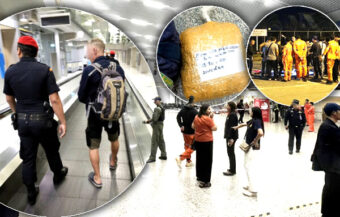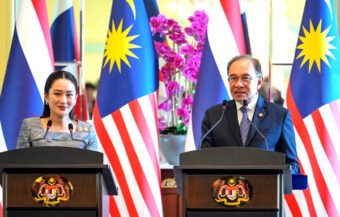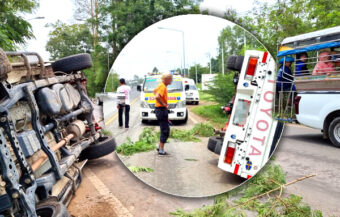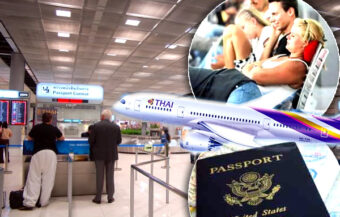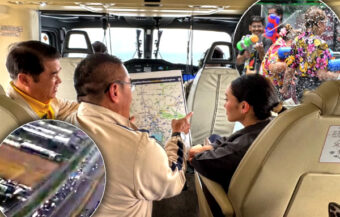Thailand’s Aviation Hub Dream. An ambitious plan for 150 million arrivals or is this pie in the sky? Certainly, PM Srettha’s bold vision faces critical hurdles. Even to regain its former position. These include Thailand’s current downgraded Federal Aviation Administration Category 2 rating, damaged airline industry confidence and Vietnam’s rise to assume the role ahead of the kingdom.
PM Srettha Thavisin, on Friday, announced plans to turn Thailand into a regional aviation hub. The announcement was made publicly on TV and social media. It certainly should be a strategic aim for Southeast Asia’s second-largest economy. At the same time, it is appropriate for a country so centrally placed in the region. Indeed, previously, Thailand enjoyed such a role. However, a disastrous review by international inspectors in January 2015 significantly damaged the country’s aviation prospects in the long term. Afterwards, this was followed by the 2020 overnight closure of Thai airspace to all carriers. This was something which caused irreparable damage to Thailand’s economy. Subsequently, the shambolic handling of access to the country during the virus emergency further damaged relationships with airlines. In short, it eroded confidence. In the meantime, Vietnam in 2019 emerged as the successor to Thailand for the role.
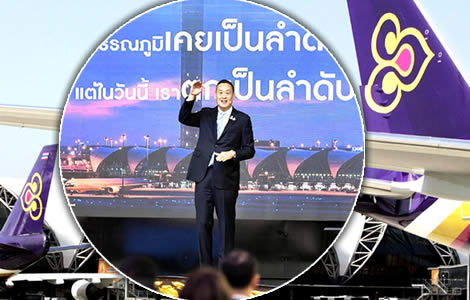
Prime Minister Srettha Thavisin’s vision for Thailand to become a regional flight hub faces critical impediments.
It comes less than a week after the tireless PM similarly announced a financial vision.
Mr Srettha urged the Stock Exchange of Thailand (SET) and Bangkok’s financial sector to become the Wall Street of Asia.
The Bangkok bourse ended 2023 15% down for the year despite other Asian exchanges rising sharply. Significantly, the performance of the SET mirrored Chinese markets where capital outflows continue.
Thailand’s efforts to raise flight connectivity are facing resistance. The factor is a key reason limiting high spending long haul tourists from visiting
Back to the flight hub plan. A top concern is that Thailand has been experiencing problems in increasing its flight connectivity rate since the pandemic. This is limiting its capacity to attract long-haul tourism. Especially from the United States. There are underlying reasons for this.
One of them is a lack of confidence in the country’s authorities. This arose after the turmoil airlines experienced following Thailand’s dramatic overnight shutdown of its airspace in 2020.
Subsequently the kingdom’s haphazard approach to allowing entry as well as draconian and unpredictable requirements. The turmoil caused many international airlines to become wary. Such concerns were openly expressed within the industry at the time.
The situation is rather similar to the long-term damage inflicted on the Chinese economy by Beijing’s crisis response. In short, viable economic markets are built on demand and trust, not government commands.
Top airline boss cautious about government’s plan to end emergency measures for foreign tourism sector
In addition, a botched plan by the Tourism Ministry to have airlines collect a passenger levy had an impact. It is understood to have caused some consternation within the industry.
Thailand bypassed or shunned by top airlines
The result is that Thailand has been effectively shunned by many airlines since. A key indicator of this is the failure of British Airways to resume its flights to Bangkok after the pandemic.
The international aviation industry giant has instead prioritised Singapore as a hub for its flights connecting with Australia. The airline has gone on record as suggesting its outbound flights to Bangkok were simply not viable.
British Airways snubs Bangkok in favour of elite travellers to Singapore as Thai Airways load levels rise
In the meantime, Thai Airways has been capitalising on the country’s struggle to increase flight capacity. The airline has rebounded into profitability. It comes less than four years after being declared bankrupt in Bangkok in May 2020.
Downgrade and red flagging of the kingdom’s aviation sector by the US Federal Aviation Administration was a massive blow to Thailand’s economy in 2015
However, an even greater impediment to Mr Strettha’s plans to develop the country as an airline hub is strikingly clear.
Thailand was downgraded by the Federal Aviation Administration (FAA) in the United States in 2015. Previously, at that time, the country was even red-flagged because it failed to meet air transportation safety standards.
The decisive move on June 18 2015 saw Thailand designated as a red flag country by the UN International Civil Aviation Organisation.
This was clearly over safety concerns.
The red flag status was imposed following a disastrous review in January 2015. That review found 33 concerns linked with aviation standards in the kingdom.
Thailand was reduced from a Category 1 country to Category 2.
In effect, it meant that US airlines could not increase flights to the kingdom. Or links between the country and the United States. The designation means Thailand is regarded as a country with subpar regulations and oversight of its air transport industry.
Subsequently, a review in 2017 saw the red flag status removed. However, Thailand has still failed to regain its Category 1 rating.
Vietnam’s emergence in 2019 with an FAA Category 1 status aviation sector as in other areas, has stolen Thailand’s lunch. The kingdom has been outplayed
In the meantime, Vietnam, in 2019 was upgraded to Category 1 status.
In addition, the Communist country is taking foreign investment opportunities from Thailand.
For example, Hanoi has managed to sign a free trade agreement with the European Union. Thailand meanwhile continues its negotiations with the 27-member bloc.
Vietnam has, in effect, stolen Thailand’s lunch when it comes to inward investment and potential growth.
The Communist country with a less than impressive human rights record as out manoeuvred Thailand on many fronts. It continues to do so and is well on its way to overtaking Thailand’s economy in the medium term.
Consequently, Thailand’s Southeast Asian competitor has been able to upgrade its cargo processing facilities with the United States.
This includes its Hanoi (HAN) and Ho Chi Minh City (SGN) airports.
Both have been upgraded and together with Singapore are in reality the Southeast Asian aviation hub that Mr Srettha aspires to.
Srettha on Friday unveiled his plan. However, it was high on aspirations and short in terms of details and addressing the key obstacles the kingdom faces
Nevertheless, on Thursday, PM Srettha unveiled bold plans to elevate Thailand’s aviation industry.
The plan aims to transform the kingdom’s regional aviation centre into a top global cargo distribution hub.
Leveraging Suvarnabhumi Airport’s strategic location, Thailand wants to become a key player in the aviation industry.
The announcement of the aviation hub project was made via Mr Srettha’s X account on Thursday. It promised to reveal essential details on Friday.
In a live broadcast at 9:30 am on Friday on TV and social media, Prime Minister Srettha Thavisin put forward his vision.
The plan called for positioning Thailand as a regional aviation hub. He said he wanted the country to become one of the world’s top five cargo distribution centres.
The question is how will this be done? Unquestionably, this will require Category 1 status from the Federal Aviation Administration.
The premier’s ambitious goals, on Friday, envisaged a transformed Thai aviation landscape. Certainly, the plan draws inspiration from Vietnam’s development initiatives in 2022.
For instance, Vietnam’s Hanoi and Ho Chi Minh City facilities thrived in 2024 amid disruptions in the Red Sea.
Airports of Thailand (AOT) boss explained the details of the ‘Ignite Thailand, Aviation Hub’ initiative which was announced publicly by the Prime Minister
Kerati Kijmanawat, president and director of Airports of Thailand (AoT), later provided insights into the project.
He briefed the media on the ‘Ignite Thailand, Aviation Hub’ campaign. In addition, he hinted at comprehensive plans to materialize the hub vision.
The plan foresees huge investment in airports and the capacity to welcome 150 million passengers a year. At the same time, it emphasized the falling rankings for Suvarnabhumi Airport which has dropped from 13th in the world to 68th.
In short, this says it all about Thailand’s ten-year decline as a hub.
Mr Kerati affirmed that AoT has submitted the plan to the prime minister and stands ready to support its implementation.
Last weekend, the PM caused consternation when he made a surprise inspection of Suvarnabhumi Airport. In truth, he was visibly not pleased by what he saw. He made his views plain.
Need to improve services at Suvarnabhumi Airport
Mr Srettha addressed these concerns this weekend. He identified a need for urgently accelerating airport services ahead of the upcoming Songkran festival.
New self-service immigration exits twice as fast and allow for tighter incoming security checks at the airport
Deranged Canadian opened out airplane passenger door as it readied for takeoff at Chiang Mai International Airport
In response, AoT has undertaken measures to enhance service quality and efficiency. Mr Kerati announced the recruitment of 800 additional airport staff to bolster security checks and passenger assistance, effective March 30.
Furthermore, the Immigration Bureau (IB) is augmenting its workforce to address immigration queues. In brief, 200 officers will join Division 2 at Suvarnabhumi Airport immediately and 400 more will follow.
Additionally, plans are underway to install 20 advanced automatic passport-check channels by June 15. 60 more channels are slated for installation by July 15, streamlining pre-departure procedures.
However, challenges persist, notably congestion at key airports such as Suvarnabhumi and Don Mueang.
Top airline boss welcomed the plan by stressing that a gigantic financial commitment will be required from the government to fund the aviation hub dream
Tassapon Bijleveld, executive chairman of Asia Aviation Plc (AAV), acknowledges the necessity of substantial investment. Certainly, this will be needed to establish Thailand as an aviation hub.
While lauding the government’s vision, Mr Tassapon highlighted infrastructure limitations. He urged long-term planning to accommodate growing demand.
He emphasized the need for expanded facilities and new airport developments to alleviate congestion and position Thailand competitively in the region.
In response to the government’s aviation aspirations, airlines have expressed cautious optimism.
Despite recognising Thailand’s potential, industry stakeholders stress the importance of addressing infrastructure constraints. The government must also commit to long-term development plans.
Mr Tassapon, for example, underlined the significance of decisive action. He urged the government to expedite expansion projects while streamlining regulatory processes.
Thai airlines appear to be flying high in 2024 with bumper profits. However, Thai Airways still has a debt of ฿120 billion after its May 2020 bankruptcy
The initiative comes amid a more positive outlook in the aviation sector itself.
Certainly, Thai Airways has returned to profitability. The national flagship carrier reported a profit of ฿7.72 billion in the quarter to September 2023. However, the airline still has an outstanding debt of ฿120 billion.
In the meantime, the country’s other airlines are also reporting improved operating results.
Asia Aviation Plc (AAV), recorded a net profit of ฿2.8 billion in the fourth quarter of 2023. At the same time, Bangkok Airways secured a net profit of ฿3 billion.
Nonetheless, as Thailand embarks on its journey to become a global aviation hub, its governance must also change.
Collaboration between government agencies and industry players is essential. The country must undoubtedly address its disastrous Category 2 US Federal Aviation Authority rating.
Even more difficult will be winning the confidence of the wider world airline sector damaged during the pandemic.
The catastrophic review of Thailand’s civil aviation sector in January 2015 and afterwards its red flag status, caused lasting harm.
Join the Thai News forum, follow Thai Examiner on Facebook here
Receive all our stories as they come out on Telegram here
Follow Thai Examiner here
Further reading:
Thailand wants to see far more US and Canadian tourists as long-haul visitors spend twice as much
Passenger complaint turbulence as Thai Airways appears to plot sky-high Dreamliner expansion
Passengers to finally get refunds from high-flying Thai Airways still facing financial turbulence
Flying high at Thai Airways as numbers skyrocket as it flies tourists into the kingdom from Europe
Thai Airways seeking business rehabilitation plan that has the unanimous support of it’s creditors

